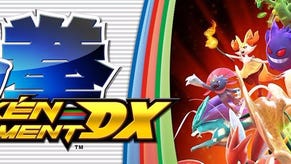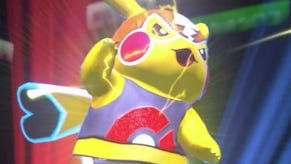Pokkén Tournament review
Monsters brawl.
At the heart of Pokkén Tournament's battle system is a change in perspective. To fully appreciate it, I needed to adjust my own.
There are two modes of combat at the heart of Bandai Namco's melding of Tekken's crunchy pugilism and the Pokémon franchise. You start in Field Phase, with the camera positioned up and over the shoulder of your Pokémon. You're given full 3D movement, though certain attacks will move the battle into Duel Phase, which resembles a more traditional one-on-one fighter. Now you're scrapping on a 2D plane, with damage scaling upward. Here, too, certain attacks will cause a shift, returning you to Field Phase.
For a while, I couldn't see the benefit to it. It's a novel hook, sure, but it feels like a contrived way to distinguish itself in a crowded genre. I began to think it was to accommodate Pokémon that favoured ranged attacks, or a way of allowing more nimble types not to be drawn into a slugfest against harder hitters. But couldn't the same have been achieved just by having more space in Duel Phase? Not least as a single, more distant camera would let two local players use the same screen rather than one being forced to view the action in soft focus on the GamePad.
Then I watched my son play, and realisation quickly dawned. Where I'd been approaching Pokkén as a fighting game, in his eyes this was simply a Pokémon game that happened to give you direct control of your monsters. I looked again at the camera's starting position in Field Phase, and it struck me that Pokémon trainers have had pretty much the same view of their opponents for 20 years (albeit a significantly less attractive one). Its purpose suddenly crystallised. It's a welcome mat; a way of making Pokémon fans new to fighting games feel more confident.You've been here before, it says. You know this.
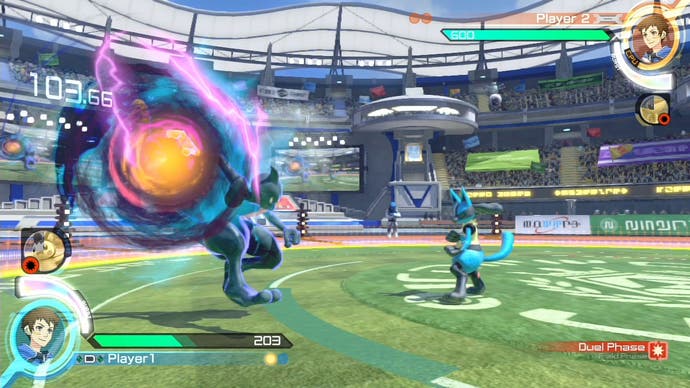
That alone makes Pokkén Tournament one of the most accessible fighting games in ages, but it's supplemented by a range of tutorials that talk you through every facet of the game. Capcom spent plenty of time bigging up Street Fighter 5's immediacy and friendliness to novices or lapsed fans, but Bandai Namco's effort doesn't just talk a good game; rather, it walks players through the basics up to the most advanced techniques. Bring up a Pokémon's move list, and it won't just tell you how to pull off certain attacks, but the scenarios in which they're best deployed, or the advantage you'll gain from using them. Seasoned players will want to turn off the in-battle tips from your advisor, but for beginners her help is invaluable: she'll offer words of encouragement, gently tell you where you're going wrong, and remind you how to deal with specific techniques. In terms of user-friendliness, it utterly embarrasses Capcom's game.
None of which would mean very much if Pokkén wasn't such a robust fighter. It's built around a straightforward attack triangle (grabs beat counters beat normal attacks beat grabs) with coloured flashes that keep the action readable even when projectiles are flying in both directions. At first, it seems a little basic, partly because the story mode - which arranges its fights into a simple league structure - is very easy at first, allowing players of any ability to breeze through the first couple of divisions with the most cursory knowledge of their Pokémon's capabilities. Button mashers rejoice! But on the final tiers, you'll likely find yourself heading into Practice mode and discovering the idiosyncrasies of its surprisingly nuanced combat. Soon you'll be thinking about wake-ups and wall jumps, combos and cancels, air recoveries and guard breaks - and how to master a roster of characters that compensates in diversity what it lacks in numbers.
There's more to consider, too. As each fight progresses, two gauges will build. The first allows you to call in a support Pokémon - these come in groups of two, and can be used to either attack or disrupt your opponent, or to buff or heal you. You can even introduce them part way through a combo, or to directly counter certain attacks. With three equippable sets from a selection of 15, you've got a wide range of ways of countering individual Pokémon or opponent play styles. If you're facing the nippy Weavile, for example, you might use Emolga's Shockwave ability to cause a temporary speed drop, thus removing his key advantage. And if you've got an opponent that likes to jump around, then Snivy's Leaf Tornado will put a stop to aerial assaults.
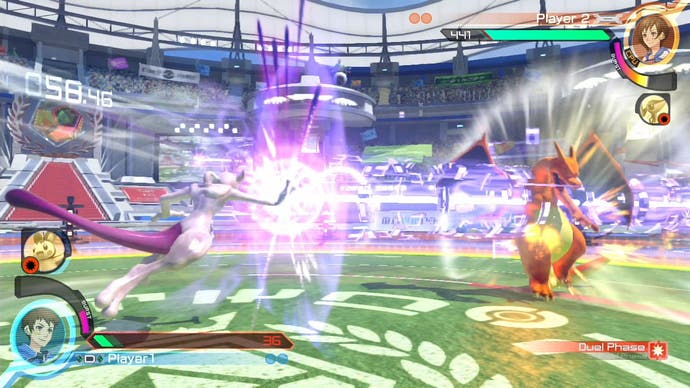
Meanwhile, as you hit and get hit (and trigger phase shifts) your Synergy meter will fill up; once it's full, you'll have access to a Burst mode, with a final attack that deals devastating damage - if it lands. You won't need to remember a series of complex inputs to pull it off - just squeeze both triggers - though you'll need to wait for the right opening, as whiffing it drains your Synergy gauge entirely while leaving you open to attack.
In truth, the elaborate animations that follow are perhaps a touch too long, but it's hard not to admire the visual wit and invention. Gengar, for example, spreads itself across the entire arena, its grinning maw opening wide to swallow its rival. Shadow Mewtwo leaps above the exosphere, conjuring a crackling orb of dark matter which it hurls back down to Earth with great force. Best of all is Pikachu Libre, in which the world's most famous Pokémon, in full luchador garb, stands on the turnbuckle of an electrified wrestling ring, leading the crown in a chant of "PI-KA-CHU!" before somersaulting and slamming its opponent into the canvas. The element of spectacle shouldn't be underestimated; people have been waiting a long time for Pokémon battles to look this good.
The acid test for any contemporary fighting game, of course, is how well it holds up online, and the early evidence is quite promising. I've experienced some instances of lag during the first few seconds of online matches, but in the main the netcode seems pretty solid. These are early days, of course, but if my opponents are anything to go by then a fair few German stores have broken release date, and I've not been left waiting long for a challenge. If it doesn't find a challenger within 10 seconds, you'll be thrown into a CPU battle, but in my experience these have been regularly interrupted within the first minute, and often much sooner.
And it's against human opponents that you'll fully grasp the value of those phase shifts. Not only do they lend the game a different rhythm from other online fighters, but they're conducive to thrilling comebacks. Small but potentially crucial amounts of HP can be recovered by causing a shift, discouraging turtling and inviting you back onto the front foot; I didn't think for a minute Pokkén would remind me of Bloodborne, but there you go. Meanwhile, if you're slammed into the energy barriers at the edges of the arena, you'll rebound to a safe distance. For ranged specialists this is obviously an absolute godsend, allowing you to wriggle off the hook when you've been backed into a corner.
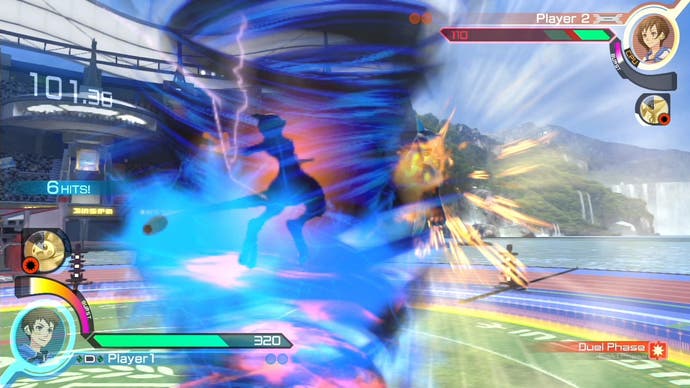
Naturally, there's the now customary levelling system, with XP allowing you to bolster your chosen monster's attack or defence stats, or to increase the speed and efficacy of their synergy and support powers. Even in defeat you'll often unlock new titles and clothes to customise your avatar, though this is scant compensation unless you're particularly fond of orange fluffy mufflers. As outlandish as some of the outfits are, they're nothing on the wonderfully barmy trainer comments, which range from "Hold up - don't get all panicky!" to "Aren't Lucario's paws adorable?" and my personal favourite, "Move Maker is my middle name."
There's something charming, too, about its keenness to maintain a consistent fiction. Like the anime, Pokkén takes a few minor liberties with the series lore, but some of the detail will wow serious Poké-nerds. Take Chandelure's Overheat, for example. In the RPGs, it deals damage, while lowering its own special attack stat by two stages; here, it's been reworked to resist hitstun, while inflicting two negative status effects on itself. And in the background of the Tellur Town stage you'll see a cyclist riding around followed closely by a Volcarona, which fans will know is a tactic used to speed up the hatching of Pokémon eggs. It's the kind of touch that reveals Pokkén's main goal. It is, of course, trying to be a great one-on-one fighter, but it's equally concerned with being a great Pokémon game.
For my money, it's a triumph on both counts, though the wider market might take some convincing. A stumbling debut in Japanese arcades - in part thanks to a more limited roster, and a rather generous playtime per credit - has earned it an undeservedly negative reputation ahead of its console release. Whether it will reach a large enough audience on Wii U to repair its standing remains to be seen, but Pokkén Tournament has earned the right to be re-examined from a fresh angle.



